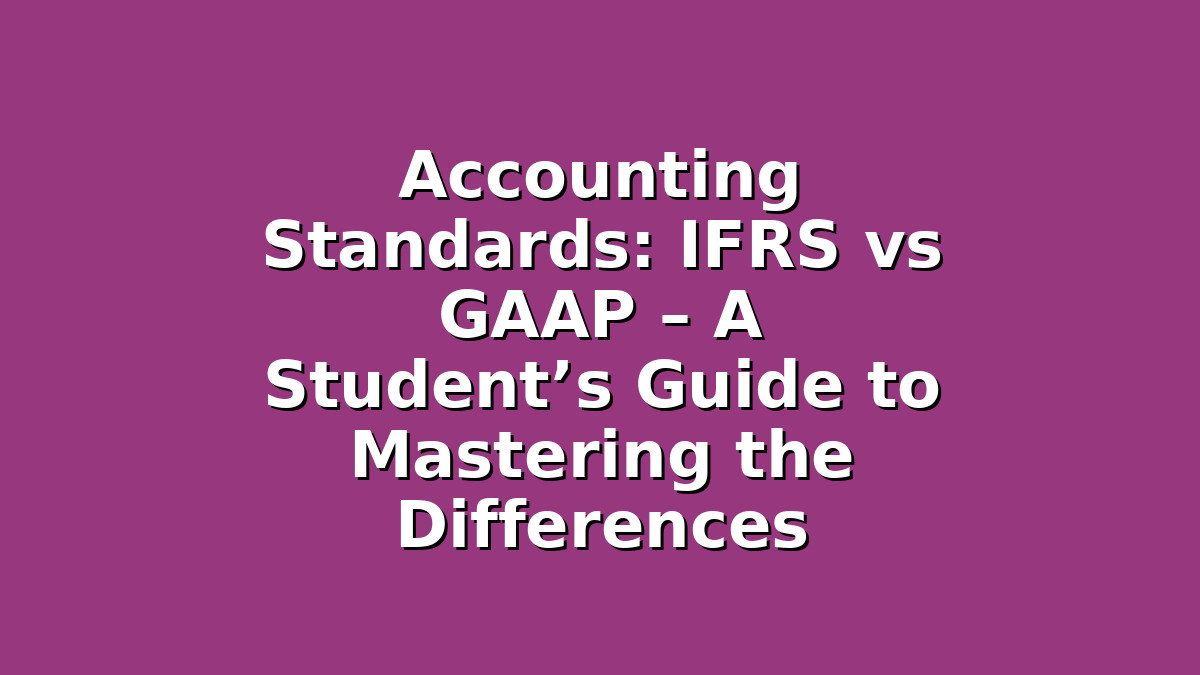Introduction
If you’re a student preparing for accounting exams or aiming to build a strong foundation in financial reporting, understanding accounting standards is crucial. Two of the most important frameworks you’ll encounter are IFRS (International Financial Reporting Standards) and GAAP (Generally Accepted Accounting Principles). Both set the rules that companies follow to prepare their financial statements, but they differ in key ways. Grasping these differences not only helps you excel in exams but also prepares you for real-world accounting challenges.
In this article, we’ll break down the essentials of IFRS and GAAP, explore their major differences, and share practical study tips to help you internalize these concepts effectively. Whether you’re studying for a university course, a professional certification, or just want to enhance your accounting knowledge, this guide will support your learning journey.
Section 1: Understanding the Basics of IFRS and GAAP
Before diving into the differences, it’s vital to understand what IFRS and GAAP actually are.
What is IFRS?
IFRS is a set of accounting standards developed by the International Accounting Standards Board (IASB) and used by over 140 countries worldwide. IFRS aims to create uniformity and transparency in financial reporting globally, making it easier for investors and stakeholders to compare companies across borders.
What is GAAP?
GAAP refers to the accounting rules followed primarily in the United States. It is established by the Financial Accounting Standards Board (FASB). GAAP offers detailed, rule-based guidance and is heavily used by U.S. companies for financial reporting.
Study Tip:
Start by creating a comparison chart that outlines the purpose, origin, and key features of each framework. Visual aids like charts or mind maps can help reinforce your understanding. Use flashcards to memorize definitions, and revisit these cards regularly to build retention.
Section 2: Key Differences Between IFRS and GAAP to Focus On
Understanding the major distinctions between IFRS and GAAP is critical for exams that test your ability to apply these standards.
1. Principles vs Rules:
IFRS is considered more principles-based, offering broader guidelines that require professional judgment. GAAP is more rules-based, with detailed prescriptions for how transactions should be reported.
2. Inventory Methods:
Under GAAP, companies can use Last-In, First-Out (LIFO) as an inventory costing method. IFRS prohibits LIFO, which can affect inventory valuation and cost of goods sold.
3. Revenue Recognition:
While both frameworks have moved closer with the introduction of ASC 606 (GAAP) and IFRS 15, subtle differences remain in application, particularly around contracts and performance obligations.
4. Financial Statement Presentation:
IFRS requires a statement of changes in equity, while GAAP allows it to be presented outside of the main financial statements. There are also differences in how other comprehensive income is reported.
5. Measurement of Assets:
IFRS often allows revaluation of property, plant, and equipment to fair value; GAAP generally does not, favoring historical cost.
Study Tip:
Focus your study sessions on understanding these differences through practical examples. Create mock financial statements applying both sets of standards to the same transaction. This approach deepens comprehension and prepares you for scenario-based exam questions. Group study can be useful here — discussing and debating differences with peers helps clarify tricky concepts.
Section 3: How to Study IFRS vs GAAP Effectively for Exams
Accounting standards can be dense and technical, but with the right strategies, you can master them efficiently.
1. Use Reliable Study Resources:
Choose textbooks, online courses, and official IASB and FASB materials that explain standards clearly. Many professional bodies offer free summaries and guides. Watching video tutorials and webinars can also make complicated topics more digestible.
2. Practice Questions and Past Papers:
Apply what you’ve learned by tackling multiple-choice questions, case studies, and past exam papers focused on IFRS and GAAP. This not only tests knowledge but also improves exam confidence.
3. Break Down Complex Topics:
When facing a lengthy standard or rule, break it into smaller parts. For example, study revenue recognition by first understanding what constitutes a contract, then performance obligations, and finally how revenue is allocated.
4. Make Use of Mnemonics and Acronyms:
Memory aids can help recall key principles and differences. For example, remember “LIFO banned” under IFRS by associating the phrase with a story or image.
5. Schedule Regular Review Sessions:
Accounting standards are cumulative. Regularly revisit material to reinforce learning and identify areas needing more attention. Use spaced repetition techniques — reviewing notes after one day, one week, and one month.
6. Connect Theory to Real Life:
Follow financial news or annual reports of companies that apply IFRS or GAAP. Seeing how standards are applied in practice makes the theory more relevant and easier to grasp.
Study Tip:
Create a study timetable that dedicates specific blocks of time to IFRS, GAAP, and their differences. Include short breaks and active study methods, such as teaching concepts to a friend or writing summary notes, to increase retention.
Conclusion
Mastering the differences between IFRS and GAAP is a smart investment in your accounting education. By building a solid understanding of both frameworks, you’ll be well-prepared for exams and professional opportunities alike. Remember to use visual aids, practice with examples, and engage actively with the material. Stay consistent with your revision, and don’t hesitate to reach out to instructors or peers when concepts seem challenging.
With dedication and strategic study habits, you can confidently navigate IFRS and GAAP and excel in your accounting journey. Keep pushing forward—you’ve got this!

Responses